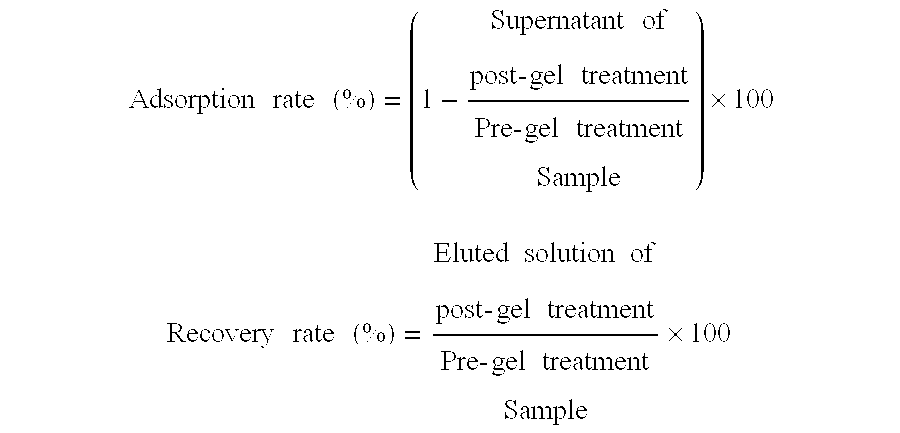Method of separating protective components of bordetella pertussis
a protective component and technology of bordetella pertussis, applied in the direction of antibacterial agents, antibacterial ingredients, peptides, etc., can solve the problems of contaminated human haptoglobin, insufficient satisfaction, and inability to remove endotoxin (et), and achieve high efficiency, high practical value, and high recovery rate
- Summary
- Abstract
- Description
- Claims
- Application Information
AI Technical Summary
Benefits of technology
Problems solved by technology
Method used
Image
Examples
example 1
[0047] Bordetella pertussis Tohama phase I strain was cultured to a final concentration of 2 billion cells / ml by Roux bottle stationary culture (450 ml, 35.degree. C., 5 days) and tank agitating culture (40 l, 35.degree. C., 2 days) using Stainer-Scholte medium, to yield a Bordetella pertussis culture.
[0048] The cell culture was concentrated to a one-tenth volume using an ultrafiltration membrane, after which it was centrifuged to separate the supernatant and cells. To the supernatant, a 1 M phosphate buffer (pH 8.0) was added to a final concentration of 0.1 M, followed by addition of an calcium acetate solution to a final concentration of 1.6 w / v% and stirring at room temperature for 1 hour. This calcium phosphate gel solution was filtered. The resulting filtrate was concentrated and desalinized to an electroconductivity of 200 umho using an ultrafiltration membrane, passed through a sulfopropyl cation exchange chromatography column (produced by Tosoh Corporation), washed with a 0....
reference example 1
[0055] To a control solution prepared by the method described in Example 1, calcium acetate was added to a final concentration of 0.5 w / v%, followed by stirring at room temperature for 1 hour. To the filtrate obtained by filtering this; calcium solution, a half amount of a saturated ammonium sulfate solution was added; the mixture was kept standing at 4.degree. C. for 7 days. This ammonium sulfate salting-out product was centrifuged; the resulting precipitate was collected and resuspended in a 0.025 M phosphate buffer (pH 7.0) supplemented with 0.25 M sodium chloride to yield a starting material. To this starting material, aluminum hydroxide gel, previously prepared to a final concentration of 0.4 mg / ml, was added; to the aluminum hydroxide gel recovered by centrifugation, ammonium sulfate was added to a final concentration of 0, 2, 4 or 8 w / v%, followed by gentle stirring at room temperature for 30 minutes. After completion of the reaction, the aluminum hydroxide gel was removed by...
example 2
[0057] To each of pertussis toxin (PT), pertussis filamentous hemagglutinin (FHA), pertactin (PRN, 69K-OMP) and pertussis fimbriae (FIM) as obtained in Example 1, a half amount of a saturated ammonium sulfate solution was added, followed by sufficient stirring. After being kept standing at 4.degree. C. for 1 week, the mixture was again centrifuged; the resulting precipitate was collected.
[0058] This precipitate was dissolved in a 0.025 M phosphate buffer (pH 7.0) supplemented with 0.25 M sodium chloride to yield a solution of pertussis toxin (PT), pertussis filamentous hemagglutinin (FHA), pertactin (PRN, 69K-OMP) or pertussis fimbriae (FIM). To each solution, a saturated ammonium sulfate solution was added to a final concentration of 4.0 v / v%. To this mixture, previously prepared, recovered aluminum hydroxide gel was added to a final concentration of 0.4 mg / ml, followed by gentle stirring for 30 minutes at room temperature. After completion of the reaction, the aluminum hydroxide g...
PUM
| Property | Measurement | Unit |
|---|---|---|
| temperature | aaaaa | aaaaa |
| temperature | aaaaa | aaaaa |
| pH | aaaaa | aaaaa |
Abstract
Description
Claims
Application Information
 Login to View More
Login to View More - R&D
- Intellectual Property
- Life Sciences
- Materials
- Tech Scout
- Unparalleled Data Quality
- Higher Quality Content
- 60% Fewer Hallucinations
Browse by: Latest US Patents, China's latest patents, Technical Efficacy Thesaurus, Application Domain, Technology Topic, Popular Technical Reports.
© 2025 PatSnap. All rights reserved.Legal|Privacy policy|Modern Slavery Act Transparency Statement|Sitemap|About US| Contact US: help@patsnap.com


